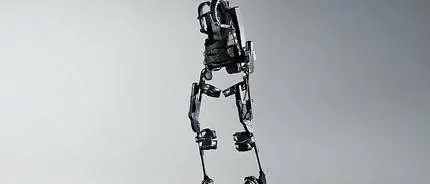Exoskeletons, also known as external or supporting robots, are support structures worn on the body that reduce the load on the body through (electro-)mechanical support and reduce the risk of injury. Exoskeletons are still in the early stages of development, but the first industrial companies are now beginning to use them in regular operations.
Active and passive exoskeletons
A distinction is generally made between passive and active exoskeletons.
Passive exoskeletons support the wearer exclusively by means of mechanical aids, such as spring or cable systems, which absorb the stresses that occur like a kind of counterweight and thus convert them into energy. Particularly when lifting heavy loads, the strain on the worker can be reduced by up to 40 percent.
Active exoskeletons provide additional external force support through electric motors or pneumatic systems that act on the wearer’s joints or other neuralgic points. These systems provide a significantly higher level of support. However, the additional power comes at a price: the suit weighs considerably more due to the motors and battery power supply. This power supply is essential, and the battery-powered suit has a limited operating time.
What are exoskeletons used for?
In logistics production, the physical demands on personnel are often very high, which in the long term puts a heavy strain on the well-being and performance of employees. Older employees in particular are often pushed to or beyond their limits when moving heavy objects, which is a major problem in an ageing society. By using exoskeletons, physical handicaps can be compensated for and postural damage and physical wear can be avoided from the outset – peak loads are eliminated.
If workplaces cannot be ergonomically optimized due to their physical characteristics, the exoskeleton can help to restore balance by stabilizing certain areas of the body and reducing the amount of force required.
Use in industry
In a very simple variant, a support structure that is limited exclusively to the legs makes it possible to adopt a variable sitting position. The worker can stiffen the mechanism fixed to the hips and legs in any position and obtain a seat that is precisely aligned to the corresponding situation. This variant, known as the chairless chair, is in operation at the Audi site in Neckarsulm, for example.
The logistics service provider Geodis in Venlo in the Netherlands relies on passive exoskeletons that support the back and thus support warehouse workers during lifting and carrying activities during order picking. The suits are currently in use by employees who have to move more than 4,000 kilograms per day.
Workers at the BMW plant in Spartanburg, USA, also receive mechanical support. They wear vests that use a mechanism to support the upper body, especially during overhead assembly.
Aircraft manufacturer Airbus is currently testing both passive and active systems to make work more ergonomic. “In aircraft production, difficult access often results in workers having to adopt very unergonomic postures. We are trying to use support systems to make this less of a health risk for employees if the workplace cannot be generally adapted,” explains development engineer Dr. Robert Goehlich in an interview with the magazine ‘Produktion’.
The economic factor
The still quite high procurement costs of this special equipment deter many companies from equipping entire departments with exoskeletons. However, according to a study by the DAK from 2014, 21.5 percent of sick days, and thus the largest share of all causes of absence, are due to diseases of the musculoskeletal system. According to David Minzenmay, a scientist at the Fraunhofer Institute for Manufacturing Engineering and Automation (IPA), this would result in approximately 125 million days of absence per year and thus a loss of value added of around 22.7 billion euros.
When you consider these figures, the investment for the employer is put into perspective. A study by ABI Research at the end of 2015 also predicts a potential market volume of 1.8 billion dollars for exoskeletons in 2025.
Where is this trend headed?
In the near future, active exoskeletons will be more compact and will be able to use sensors to detect when the wearer needs support, and then provide targeted assistance. For example, the system will measure the strain via special gloves and use a weight estimate to determine how much external energy is needed. A solution of this kind is currently being developed in the research project SensHand by the German Federal Ministry of Education and Research (BMBF) in collaboration with the Fraunhofer IPA.
The Fraunhofer IPA is also researching a modular box that allows the individual assembly of individual exoskeleton components for different applications. If this system reaches market maturity, investment costs could fall considerably and the prevalence of supporting systems could increase significantly.
Further information on ergonomic aspects can be found in the article Ergonomics in the warehouse.
Image source teaser: Ekso Bionics, license (CC BY-ND 2.0)
